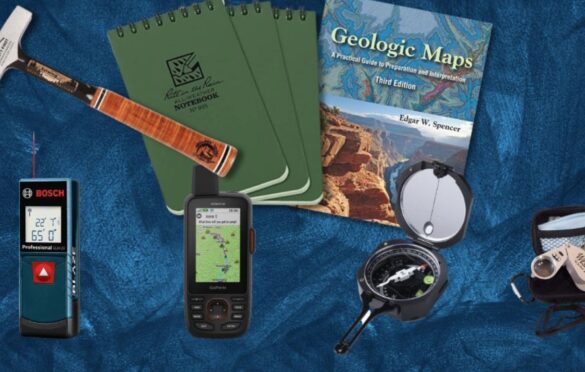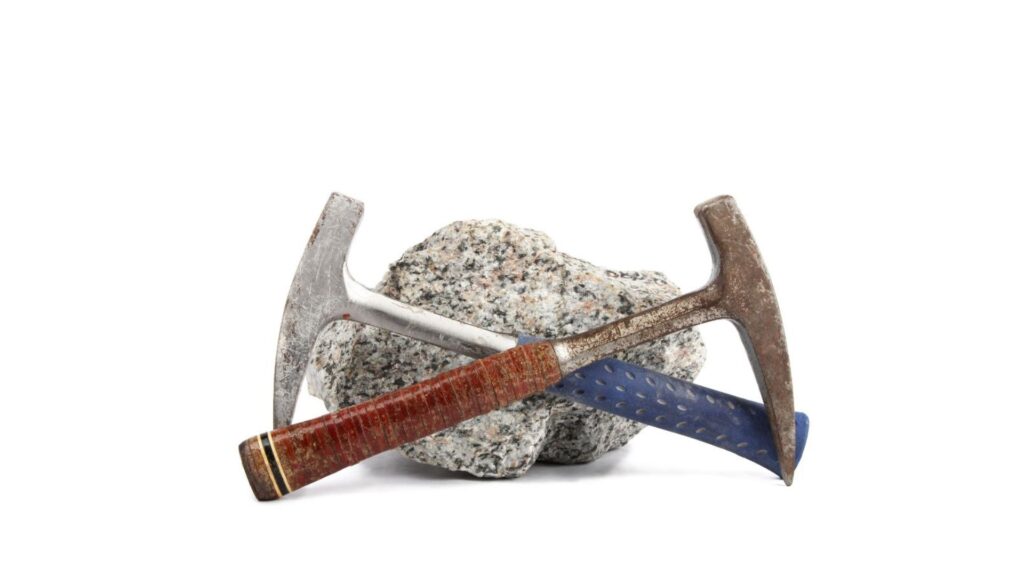Geology Tools: Unveiling the Essentials for Field Exploration

Introduction
Geology is the scientific study of the Earth’s structure, composition, and processes that have shaped the planet over billions of years. In this exciting field of research, geologists heavily rely on a wide range of specialized equipment to uncover the Earth’s mysteries and collect valuable data for analysis. From traditional essentials to cutting-edge technologies, geology tools play a vital role in enabling geologists to explore and understand the Earth’s dynamic history.
What is Geological Equipment?
Geological equipment refers to a diverse array of instruments and tools designed to aid geologists in conducting fieldwork, collecting samples, analyzing geological features, and making accurate observations. Whether it’s exploring remote landscapes or studying rocks and minerals up close, these tools are indispensable for any geological expedition.

List of Geological Equipment Used in the Field
Geological Hammer: The geological hammer, also known as a rock pick or geology pick, is perhaps the most iconic and fundamental tool in a geologist’s kit. This sturdy and versatile tool is used for breaking rocks, collecting samples, and examining the texture and mineralogy of various geological formations.
Hand Lens (Loupe): A hand lens is a small magnifying glass that allows geologists to observe fine details and mineral characteristics of rock and mineral specimens. With its high magnification power, it aids in the identification of minerals and helps geologists understand the rock’s history.
Compass Clinometer: A compass clinometer is a navigational instrument that measures the orientation of geological structures and rock layers. It helps geologists determine the strike and dip of rock formations, enabling them to interpret the geological history of the area.
Geological Compass: Unlike the compass clinometer, a geological compass is specifically designed for geological mapping. It provides precise measurements of azimuths and dip angles, facilitating accurate mapping of rock outcrops and structures.
GPS Device: Global Positioning System (GPS) devices have become essential tools for geologists to navigate vast and rugged terrains. By providing accurate coordinates, a GPS enables geologists to mark and record important geological features during their fieldwork.
Core Drilling Rig: Core drilling rigs are heavy-duty machines used to extract cylindrical samples of rock, known as cores, from the subsurface. These cores offer valuable insights into the geological composition and stratigraphy of an area.
Sieve Set and Sieve Shaker: Geologists often use sieve sets and shakers to analyze soil and sediment samples. By separating particles into different size fractions, they can understand the distribution and composition of materials.
UV Lamp (Blacklight): Geologists employ UV lamps to identify certain minerals that fluoresce under ultraviolet light. This helps in distinguishing different mineral species and aids in mineralogical analysis.
Geological Field Notebook: A reliable field notebook is crucial for geologists to record observations, sketches, and data during fieldwork. It acts as a valuable reference for subsequent analysis and report writing.
Camera: A good-quality camera is essential for capturing high-resolution images of geological features, rock formations, and landscape views. These images are valuable additions to reports and presentations.
Safety Gear: Safety is paramount in geological fieldwork. Essential safety gear includes hard hats, sturdy boots, safety goggles, gloves, and other protective equipment.
Geological Hammer: A Rock Breaker and Time Machine
The geological hammer, often made of sturdy steel, features a chisel-like end for breaking rocks and a pointed tip for precise extraction of samples. Geologists use this tool to examine the texture, mineralogy, and structure of various rock formations. By carefully analyzing the layers and features within rocks, geologists can unravel the Earth’s geological history and gain insights into past environments, climate changes, and tectonic events.
Hand Lens (Loupe): Revealing the Microscopic World of Minerals
The hand lens, a small but powerful magnifying glass, enables geologists to observe and identify the fine details of mineral specimens. By closely examining the crystal shapes, color, and cleavage patterns, geologists can determine the mineral’s identity and characteristics. This tool is particularly useful when identifying minerals that appear similar to the naked eye but have distinct properties under magnification.
Compass Clinometer: Navigating Geological Structures
A compass clinometer is an indispensable tool for geologists to measure the orientation of geological structures, such as faults, folds, and bedding planes. By determining the strike (the direction of a horizontal line on a tilted surface) and dip (the angle of inclination of a geological feature), geologists can interpret the geological processes that have shaped the landscape over time.
Geological Compass: Precision Mapping for Detailed Analysis
The geological compass is a specialized tool designed for accurate geological mapping. It allows geologists to record azimuths (compass bearings) and dip angles of rock outcrops and other geological features. By meticulously mapping these structures in the field, geologists can create detailed geological maps, cross-sections, and 3D models, aiding in the analysis of complex geological relationships.
GPS Device: Navigating Remote Terrain with Precision
Global Positioning System (GPS) devices have revolutionized field exploration for geologists. These handheld devices use satellite signals to provide precise geographic coordinates, facilitating navigation in remote and challenging terrains. GPS devices allow geologists to mark and locate specific geological points of interest accurately, ensuring comprehensive data collection during field surveys.
Core Drilling Rig: Unearthing the Subsurface Secrets
Core drilling rigs are heavy-duty machines used to extract cylindrical rock samples, or cores, from the subsurface. Geologists employ this equipment when studying deeper geological formations, such as bedrock and sediment layers. Cores provide critical information about the Earth’s past, including the age of rocks, paleoclimate data, and even evidence of past life forms.
Sieve Set and Sieve Shaker: Analyzing Soil and Sediment Composition
Geologists use sieve sets and shakers to analyze soil and sediment samples collected from various locations. By separating these samples into different size fractions, geologists can determine the distribution and composition of particles. This information is crucial for understanding the soil’s fertility, sediment transport, and potential geological hazards.
UV Lamp (Blacklight): Illuminating the World of Fluorescent Minerals
A UV lamp, also known as a blacklight, is a valuable tool for identifying minerals that fluoresce under ultraviolet light. Certain minerals emit distinctive colors when exposed to UV light, aiding geologists in distinguishing between different mineral species. This information is crucial for understanding the geological processes that formed specific rocks and minerals.
Geological Field Notebook: The Geologist’s Trusted Companion
A geological field notebook is a geologist’s primary record-keeping tool during fieldwork. It serves as a journal to document observations, sketches, sample locations, and data collected during geological expeditions. By keeping detailed notes, geologists ensure accurate data collection, better analysis, and comprehensive reports when they return to the lab.
Camera: Capturing Earth’s Beauty and Complexity
A good-quality camera is essential for geologists to capture high-resolution images of geological features, rock formations, and landscape views. These visual records provide invaluable documentation of field findings and serve as supporting material in reports, presentations, and scientific publications. Photographs can also be used for educational purposes and sharing the wonders of geology with the wider community.
Safety Gear: Ensuring Geologists’ Well-Being
Safety gear is of paramount importance for geologists working in the field. Hard hats protect against falling rocks, sturdy boots offer stability on rugged terrain, safety goggles shield eyes from hazardous materials, and gloves provide protection while handling sharp tools and rough samples. By prioritizing safety, geologists can focus on their research without unnecessary risks.
Conclusion
Geology tools serve as the gateway to understanding the Earth’s vast history and complex geological processes. From the iconic geological hammer to modern instruments like portable XRF analyzers, these tools empower geologists to explore and decode the planet’s secrets in diverse terrains. Each tool plays a specific role in the geologist’s arsenal, helping them collect accurate data, make informed interpretations, and contribute to scientific advancements.
As technology continues to evolve, geology tools will undoubtedly become more sophisticated, enhancing the efficiency and depth of geological research. However, no matter how advanced the equipment may become, the spirit of exploration, curiosity, and wonder will remain the driving force behind every geologist’s journey into the heart of our dynamic and ever-evolving planet. Happy geologizing!
Remember, geological fieldwork can be physically demanding and may involve hazardous conditions. Always prioritize safety and adhere to the necessary precautions to ensure a successful and incident-free expedition.
